Art World
What’s the Best Work of Art You Saw This Summer? 18 Well-Traveled Experts Weigh In
In the first of a two-part series, Alfredo Jaar, Melissa Chiu, and others tell us about the most memorable art they saw all season.
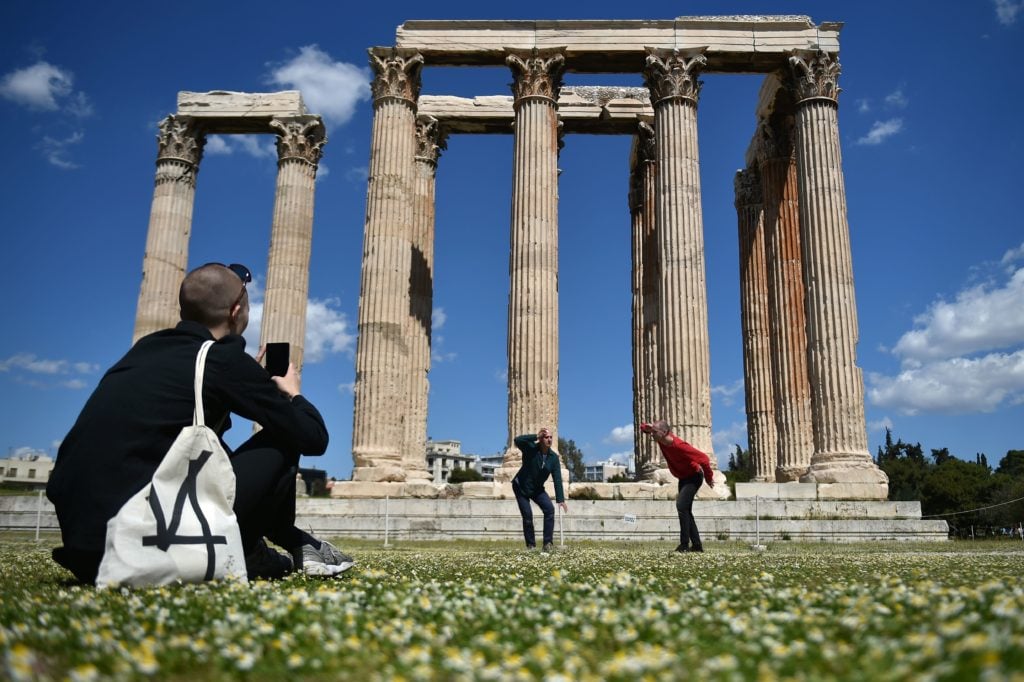
In the first of a two-part series, Alfredo Jaar, Melissa Chiu, and others tell us about the most memorable art they saw all season.

Some people spend the summer swimming at the beach or reading at a lakeside cabin. Workaholic members of the art world, however, seem to spend their summers doing what they always do: looking at art. This year’s calendar was particularly jam-packed, with documenta 14, the Venice Biennale, and the Skulptur Projekte Münster coinciding for the first time in a decade.
We asked curators, museum directors, auction house executives, artists, and others to pick the best work of art they saw this summer—and tell us why they can’t get it out of their heads. The answers will take you from a remote hilltop installations in Athens to New York’s bustling High Line. We’ve rounded them up in two parts—stay tuned for the second tomorrow.
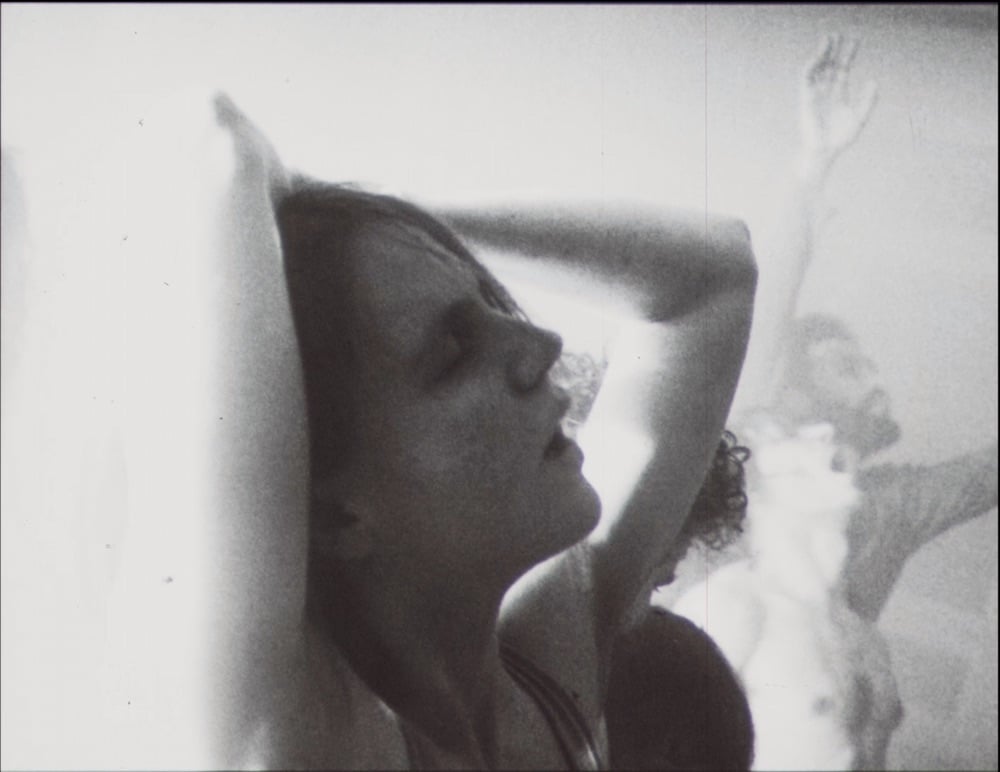
Still from Jeremy Shaw’s Liminals (2017) at the Venice Biennale. Courtesy of the artist and KÖNIG Galerie, Berlin.
One piece that particularly struck me this summer was Jeremy Shaw’s film Liminals at the Venice Biennale, which is about the future of extinction in which we find “periphery altruist cultures” that try to save humankind through forced evolution. One of these groups is the Liminals, who use forgotten rituals to access a space between the physical and the virtual. Shaw’s video-installation initially seems to be a ’60s or ’70s black-and-white documentary, but dramatically shifts into a digital sci-fi film that creates a state of trance via immersed sound, visual effects, and strobe lights. Shaw’s para-fictional work engages various cathartic behaviors including modern dance, Kundalini, and head-banging. I found the work hypnotizing and could not get it out of my mind.
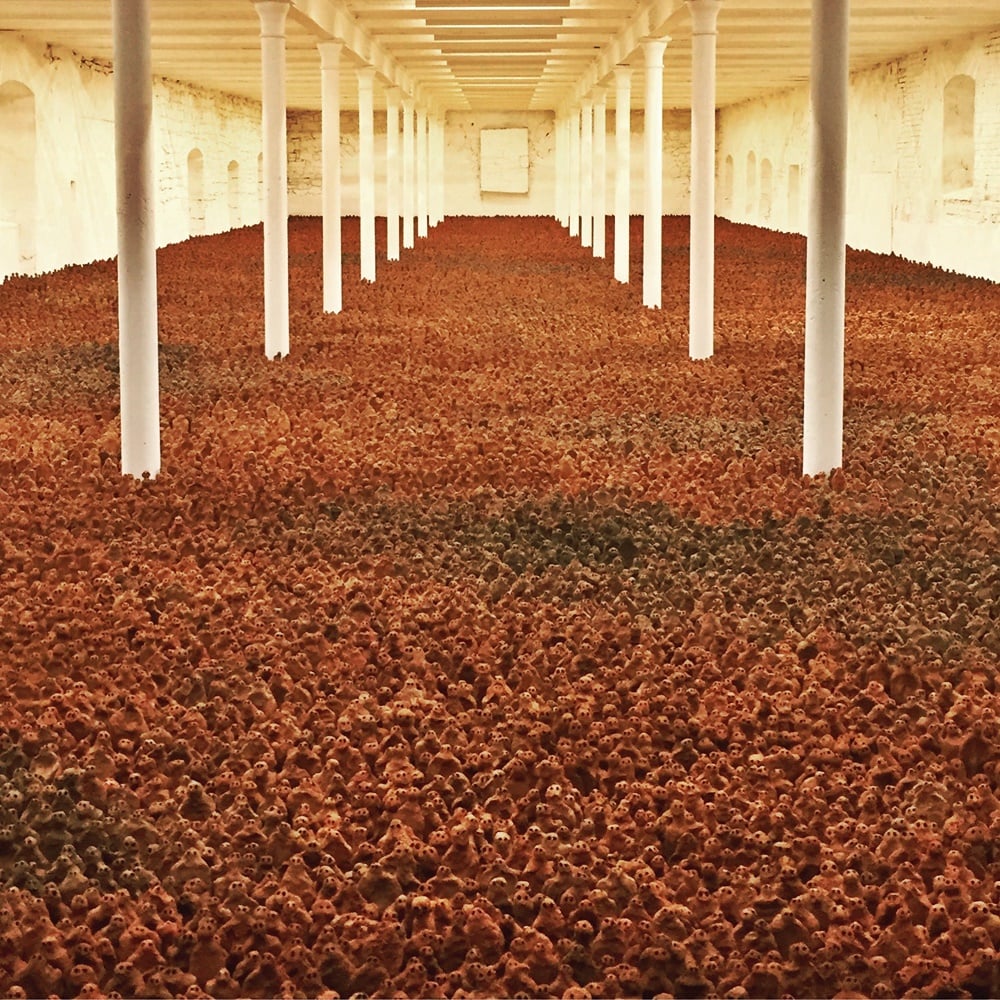
Antony Gormley’s European Field at the Hall Art Foundation in Derneburg, Germany. Photo by Jean-Paul Engelen.
My favorite piece that I’ve been lucky enough to see this summer was Antony Gormley’s European Field, an installation at the Hall Art Foundation in Derneburg, Germany. The institution, which was Georg Baselitz’s former studio and castle, is striking in and of itself and European Field is sublimely installed in a building on the castle’s idyllic grounds. To reach the work, you must walk through a dark corridor until you turn a corner and find yourself surprised by the sight of 35,000 clay figures staring back at you. From a social perspective, it makes you think of all the streams of refugees fleeing conflict areas around the world. From an art historical perspective, it immediately made me think of Walter De Maria’s New York Earth Room—a similarly all-encompassing experience.
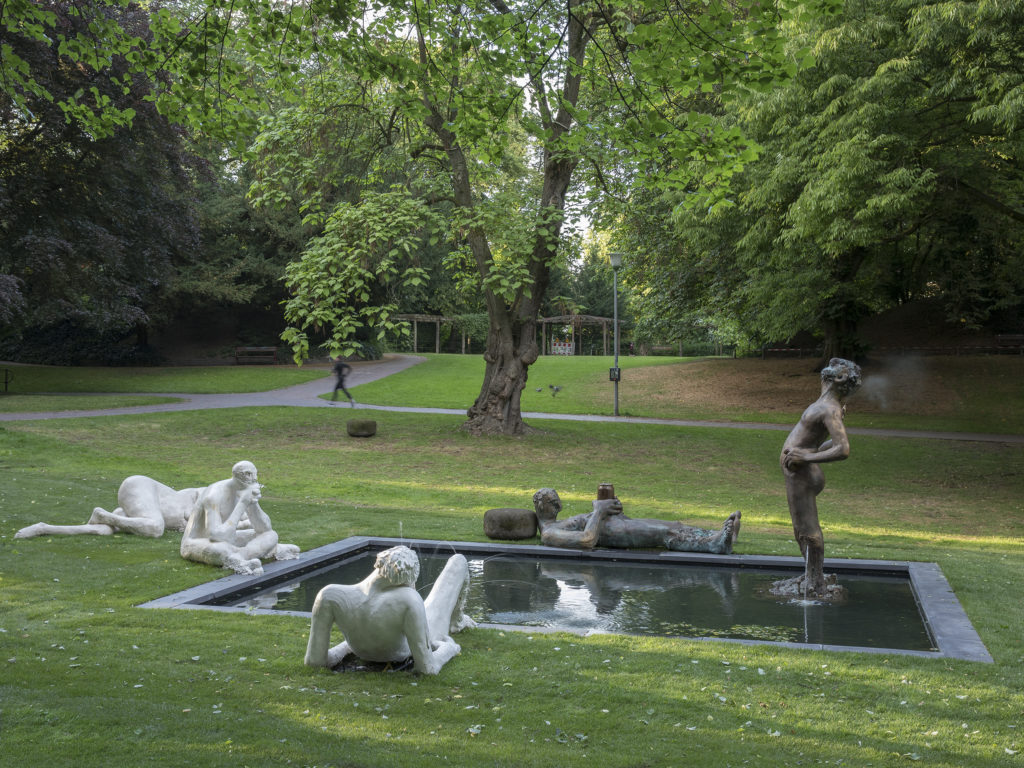
Nicole Eisenman’s Sketch for a Fountain (2017) at the Skulptur Projekte in Münster. © Skulptur Projekte, photo by Henning Rogge.
I loved Nicole Eisenman’s Sketch For a Fountain, her contribution to the Skulptur Projekte Münster. It’s a work that questions the tradition of classic fountains in European gardens, but with playfulness and levity. Rather than sensual nymphs or chubby cherubs, Eisenman’s work portrays five figures caught in quotidian activities, like drinking beer, contemplating the landscape, or simply lounging by the water. It was great to see how people absolutely loved it and interacted with it. A contemporary version of Le Déjeuner sur l’herbe!
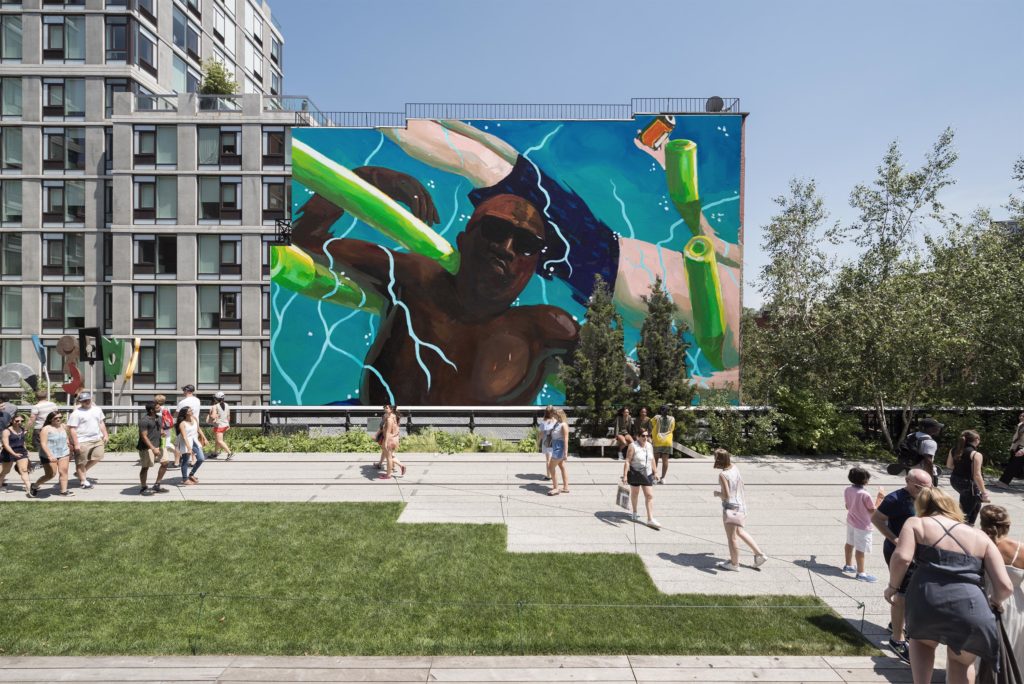
Henry Taylor’s The Floaters (2017) at the High Line. Courtesy of Blum & Poe, LA/NY/Tokyo, and Friends of the High Line. © Henry Taylor.
Henry Taylor’s The Floaters mural on the High Line, at West 22nd Street. It’s the perfect outdoor summer artwork! Makes you want to dive right in.
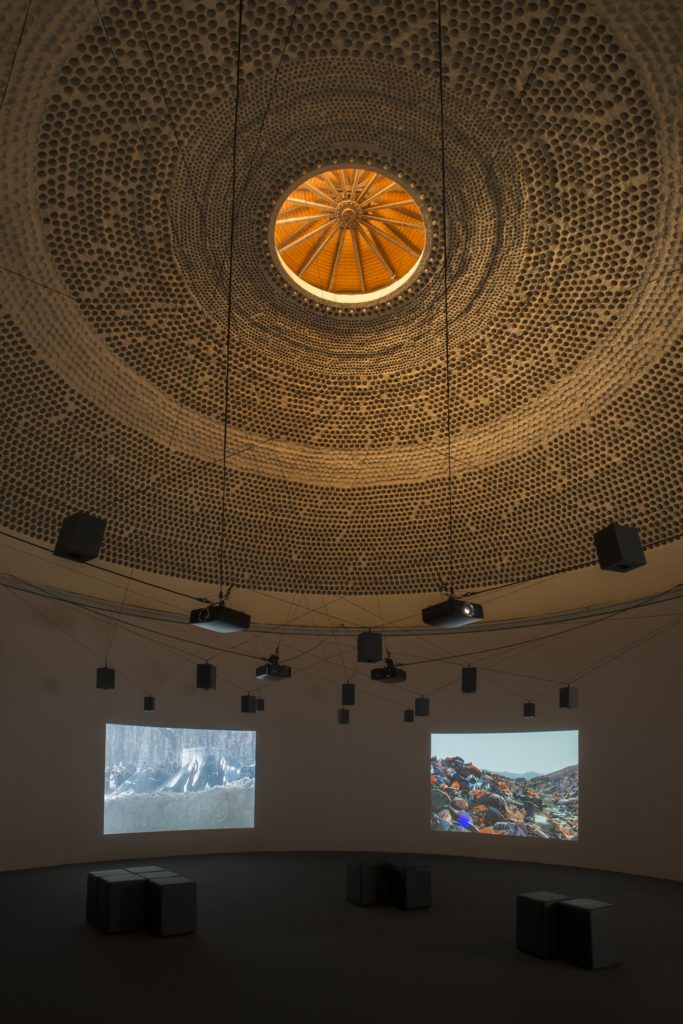
Installation view of Angela Melitopoulos’s Crossings (2017) at documenta 14 in Kassel. © VG-Bildkunst Bonn 2017 Giesshaus. © Nils Klinger.
It’s really hard for me to choose just one… My highlight from documenta 14 in Kassel was the extraordinary work of Angela Melitopoulos, an artist who explores issues to do with ecology and the role of documentaries. In Venice, I was struck by the Barbuda Pavilion, which nobody talked about, showcasing the fantastic work of Frank Walter, an outsider who’s never been in the art system. In Münster, Pierre Huyghe presented a masterpiece, an ecosystem where science, art, landscape, and philosophy came together.

Visitors engaging with teamLab’s Jungle at Shibuya Hikarie in Tokyo. © teamLab Jungle Art Night.
I spent some time in Tokyo this summer and had a chance to visit teamLab’s Jungle, an interactive performance at Shibuya Hikarie, in which music and light respond to the movements and sounds of bystanders. teamLab’s kaleidoscopic environments place the viewer in immersive, alternate realities, each one unique and unfamiliar.
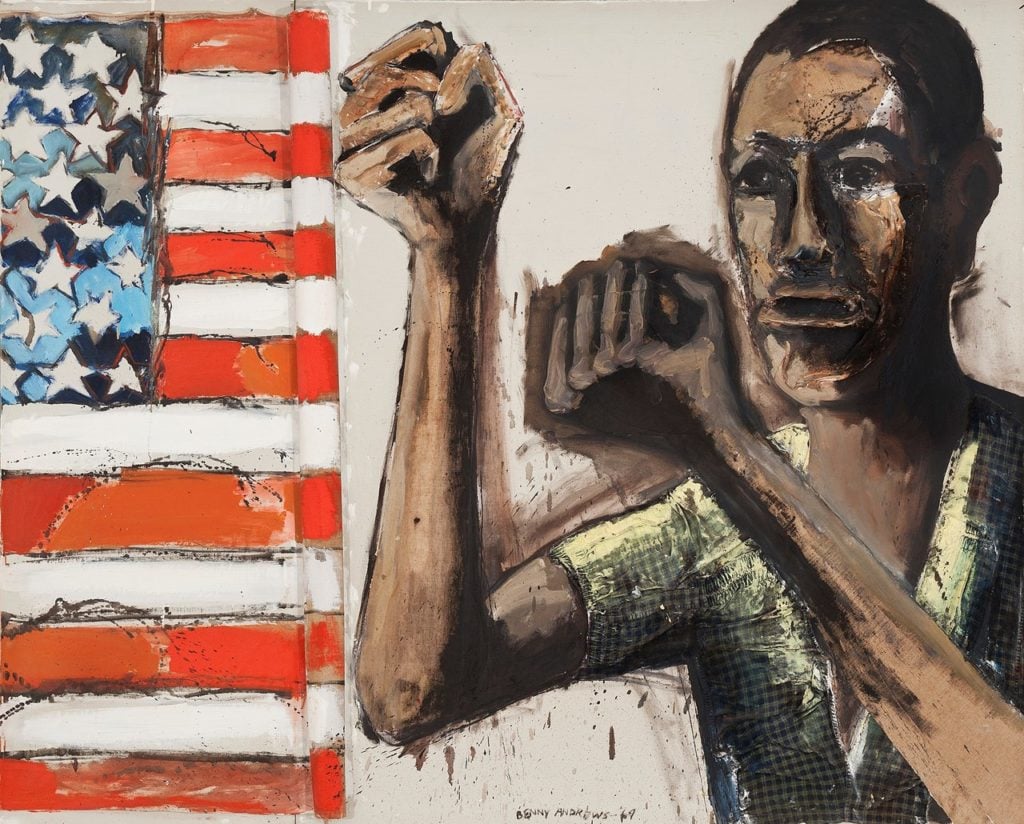
Benny Andrews’s Did the Bear Sit Under a Tree (1969) at “Soul of a Nation: Art in the Age of Black Power” at Tate Modern. © Estate of Benny Andrews/DACS, London/VAGA, NY.
One of the most powerful works I’ve seen this summer was Benny Andrews’s Did the Bear Sit Under a Tree? (1969), up now in the Tate Modern’s groundbreaking exhibition, “Soul of A Nation: Art in the Age of Black Power.” In Andrews’s poignant work, the stars and stripes of an American flag are rolled back to reveal a frustrated African American man waving his fists both at the flag and the viewer. Giving the figure a zip for a mouth, Andrews skillfully manages to reflect the anger many African Americans first felt in the wake of the Civil Rights Movement. By the late 1960s, there were more militant calls for Black Power: a rallying cry for African American pride, autonomy, and solidarity that drew inspiration from newly independent African nations. Andrews’s work, while completed in 1969, feels very contemporary, connecting potently with the increasing dissatisfaction with our current political system, particularly in light of the fatal shootings of African American men and women nationwide by police officers in the line of duty.
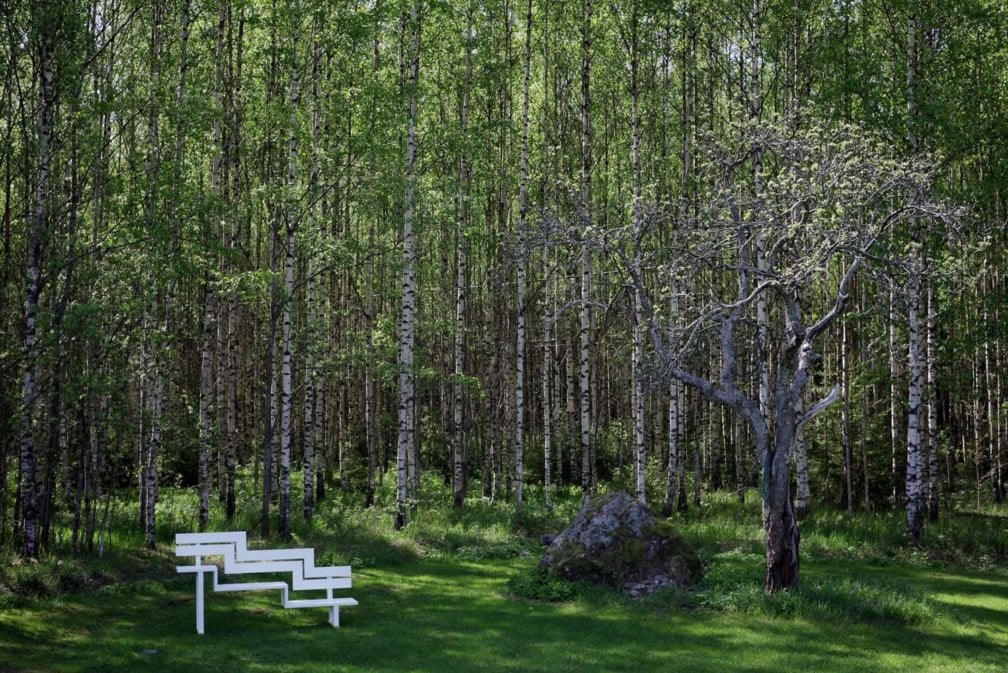
Jeppe Hein’s Modified Social Benches (2005-8) at the Zabludowicz Collection in Sarvisalo. Installation view, Sarvisalo, Finland. Photo: David Bebber.
My favorite is Jeppe Hein’s sculptures at the Zabludowicz Collection Sarvisalo. I have always been a fan of his work and I think it works best in nature. I love the contrast between his relatively small, humorous sculptures and the overwhelming and majestic nature of Sarvisalo.
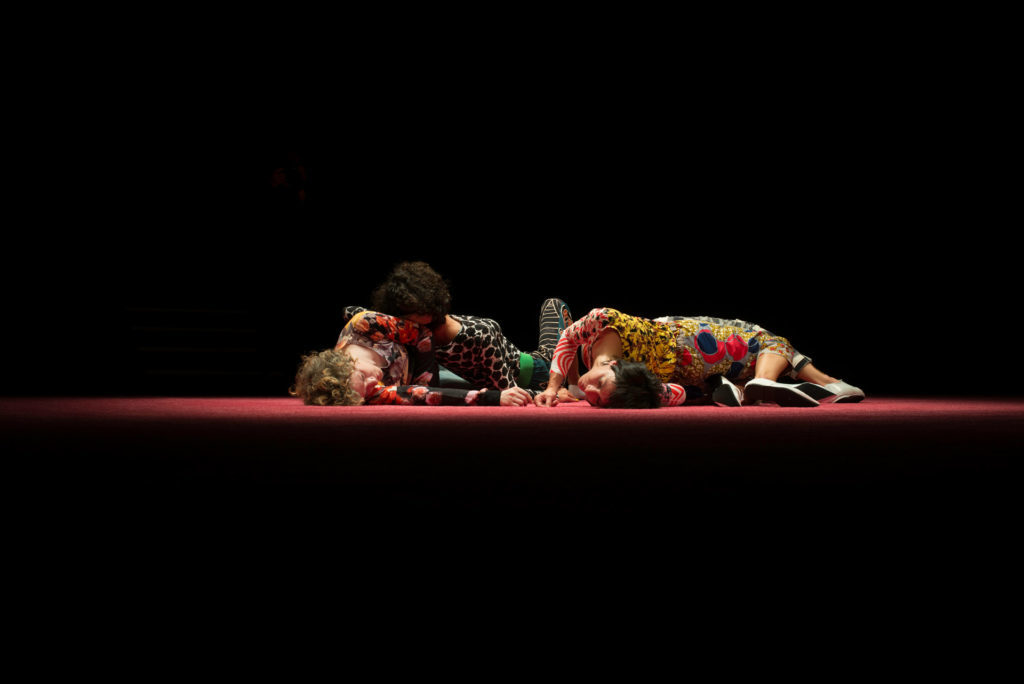
Maria Hassabi’s Staged? at the Onassis Cultural Center, Athens, Greece (2017). Image © Maria Hassabi.
Maria Hassabi’s performance piece, Staged?, at the Onassis Cultural Centre in Athens. This took place parallel to the opening days of documenta 14 in Athens and was one of the most physically grueling performances I’ve ever witnessed. Four performers moving in glacially slow motion in syncopation with increasingly intense lighting and an atonal soundtrack: a series of human dazzle patterns, totally hypnotic.
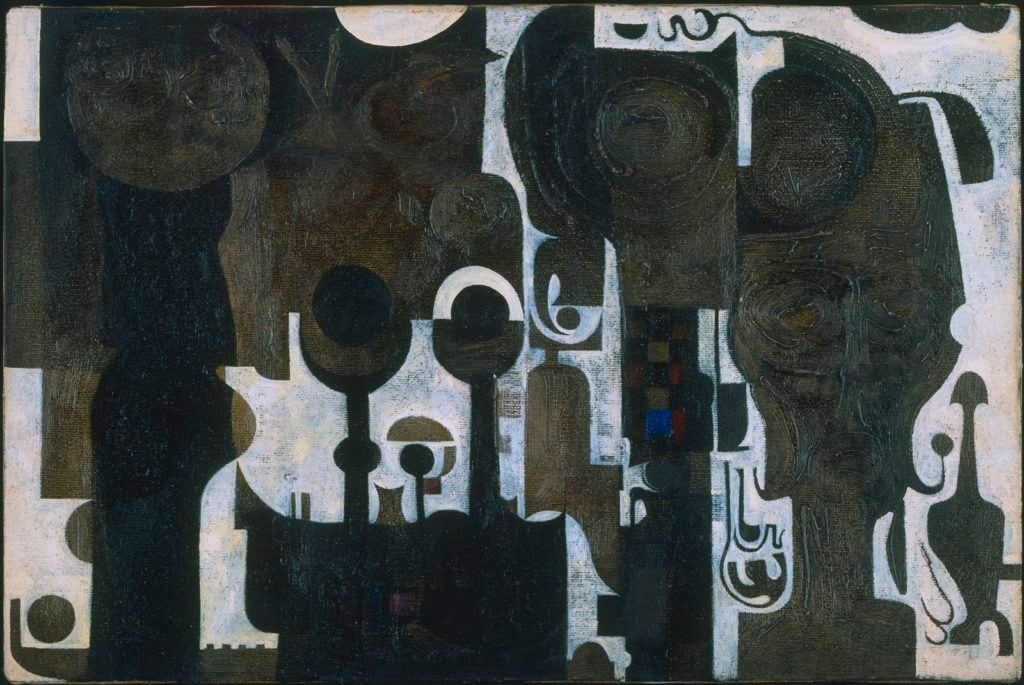
Ibrahim El Salahi’s The Mosque (1964). Courtesy of the Museum of Modern Art, New York.
The best work I have seen this summer is a painting by Sudanese artist Ibrahim El Salahi, titled The Mosque, which now hangs in the Museum of Modern Art (MoMA) in New York City. The Mosque includes numerous themes of that era, including calligraphy, landscape, and figurative and Islamic references. What makes this work so special is that it was personally chosen by Alfred H. Barr Jr, the museum’s founding director, when he met El Salahi in the mid-’60s in New York. Sadly, the work had not been seen for 50 years. MoMA decided to finally display the work following Trump’s executive order of January 27th, 2017, which banned visitors from certain Muslim countries, as part of the museum’s protest against that ban. Despite its small size (12⅛ by 18⅛ inches), it is politically significant in that it was part of MoMA’s initial effort to globalize its collection.
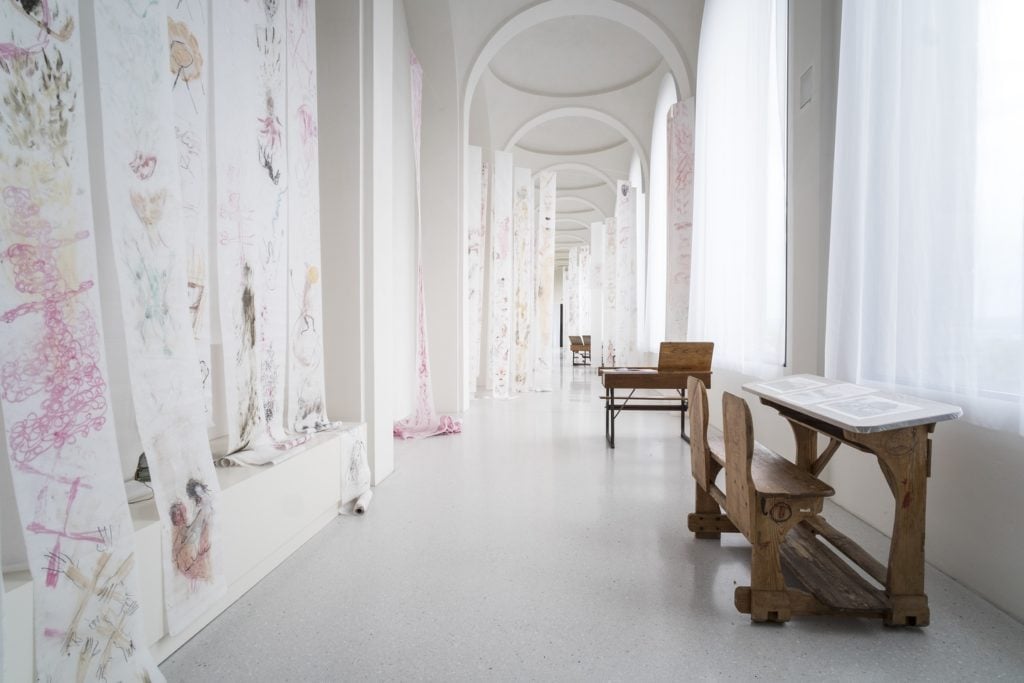
Installation view of Pélagie Gbaguidi’s The Missing Link, Dicolonisation Education by Mrs Smiling Stone (2017). Courtesy of Neue Galerie, Kassel, documenta 14, photo: Mathias Völzke.
One work especially has stayed with me from both halves of this summer’s documenta 14: Pélagie Gbaguidi’s The Missing Link, a powerfully complex installation. The French artist’s visceral drawings of falling bodies, executed on long rolls of paper hanging from the ceiling, descended onto school desks whose surfaces were wrapped in translucent paper; beneath the wrapping I could make out black-and-white photographs of student uprisings in South Africa, as well as excerpts of the Code Noir, the 18th-century law that instituted slavery in the French colonies. Hidden too, within the installation, were small video screens, on which Gbaguidi performed haunting invocations. From a sprawling Documenta, Gbaguidi’s moving study of education, segregation, history, and memory is one that has endured the most for me.
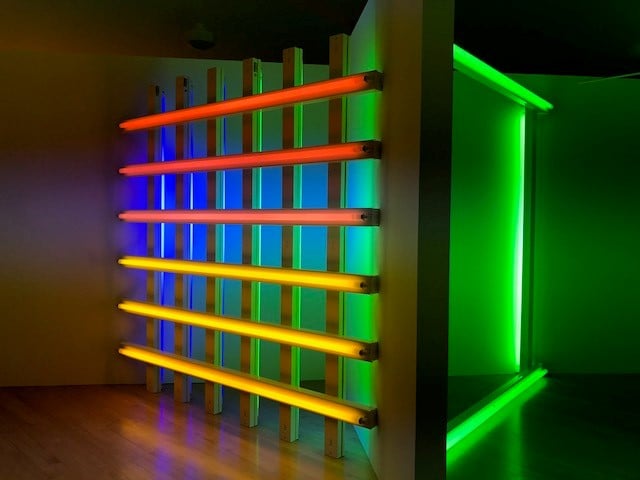
Dan Flavin’s untitled (in honor of Harold Joachim) 3 (1977) and untitled (to Katharina and Christoph) (1971), at the Dan Flavin Art Institute. Photo by Andrea Glimcher.
The best work of art I saw this summer is actually a perennial favorite venue: The Dan Flavin Art Institute, a Dia Art Foundation space, located off Main Street in Bridgehampton, New York. It is modest in scale—offering the perfect blend of art, architecture, and local history—but the presentation is impactful and impressive. Originally, in the early 1900s, the building was the town’s firehouse. Later, it housed a Baptist church, and then Dia acquired it in 1979 for exhibitions and a permanent mini-retrospective of works by Dan Flavin, who lived and worked nearby. This summer, paintings and ceramics by Mary Heilmann are beautifully presented on the ground floor, and nine Flavin fluorescent light sculptures from 1963–81 and one large pencil and chalk drawing on paper are perfectly installed on the second floor. In a tiny space behind the Flavin gallery is a small doorway where there’s a pedestal displaying a stone (cornerstone?) from the church. Once you move inside that room, there’s an installation of related objects: a reference to the building’s past and likely a nod to the power of transformative experiences. Everything about this focused, intimate institute is intelligent and substantial. Here art, architecture, and history form a kind of trinity.
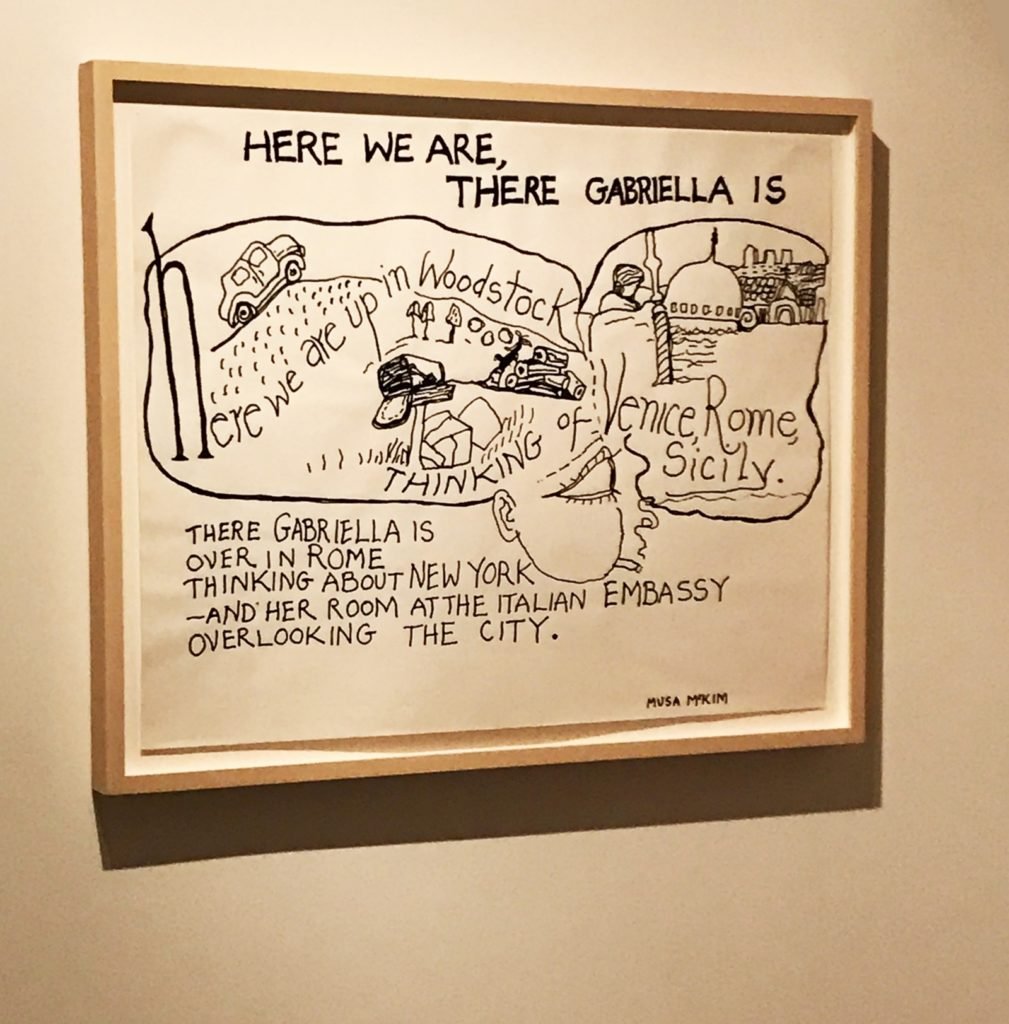
Drawing from “Philip Guston and the Poets” at Gallerie dell’Accademia in Venice.
“Philip Guston and the Poets” at the Gallerie dell’Accademia di Venezia was a highlight for anyone lucky enough to be in Venice for the Biennale this summer. The breadth of this exhibition was overwhelming—and while I lusted over the 1950s abstract paintings, it was actually a work on paper in a smaller gallery off to the side that I can’t stop thinking about called “Here we are, up in Woodstock thinking of Venice, Rome, Sicily…” Exactly a year ago, I bought a piece of land in Woodstock—minutes away from where Guston moved permanently in 1967 and died in 1980. I had been in Venice for a week when I saw the show. I was tired, hungover, art-ed out. And here was this drawing that spoke directly to me about love and homesickness and wanderlust. I walked out of the Accademia and looked out at the sparkling ripples of the canal and thought, “It’s time to go home.”
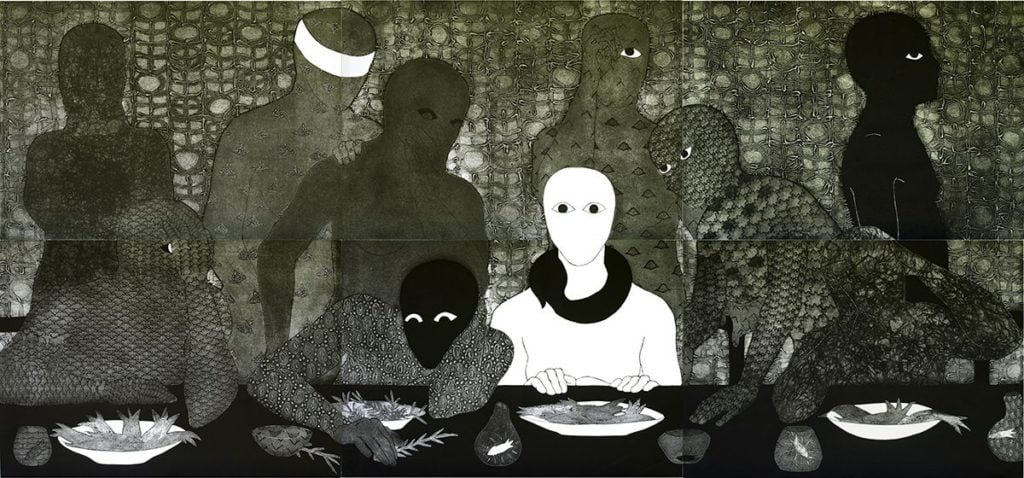
Belkis Ayón’s La cena (Last Supper) (1991), in “NKame: A Retrospective of Cuban Printmaker Belkis Ayón,” at El Museo del Barrio. Collection of the Belkis Ayón Estate.
La cena is the first work you see when entering this generous retrospective of innovative printmaker Belkis Ayón on view at El Museo del Barrio. There’s a version from 1991 in stark black and white that not only powerfully isolates the gleaming, individuated eyes that mark her unmistakable figures (drawn from Afro-Cuban Abakuá mythology), but also allows one to see the textured, patterned results of her labor-intensive, large-scale collagraph prints in rich contrast. Nearby permutations of the subject incorporate earthier tones, or vibrant colors. The show gains power from there on, displaying her technical experimentation and symbol-charged compositions in depth, but the first eye contact with La cena is pretty much unforgettable.

Still from Grada Kilomba’s Illusions (2017), from “The Parliament of Bodies: How does it feel to be a problem?” at documenta 14 in Kassel. Image courtesy of Alfredo Jaar, 2017.
In Kassel, Grada Kilomba’s Illusions (2017)—part of the documenta 14 public program “The Parliament of Bodies: How does it feel to be a problem?”—is a brilliant work of exceptional depth and beauty that demands that its audience forcefully, but poetically, confront our ever-present colonial reality, and our ever-present racism, and imagine a new geography of the future.
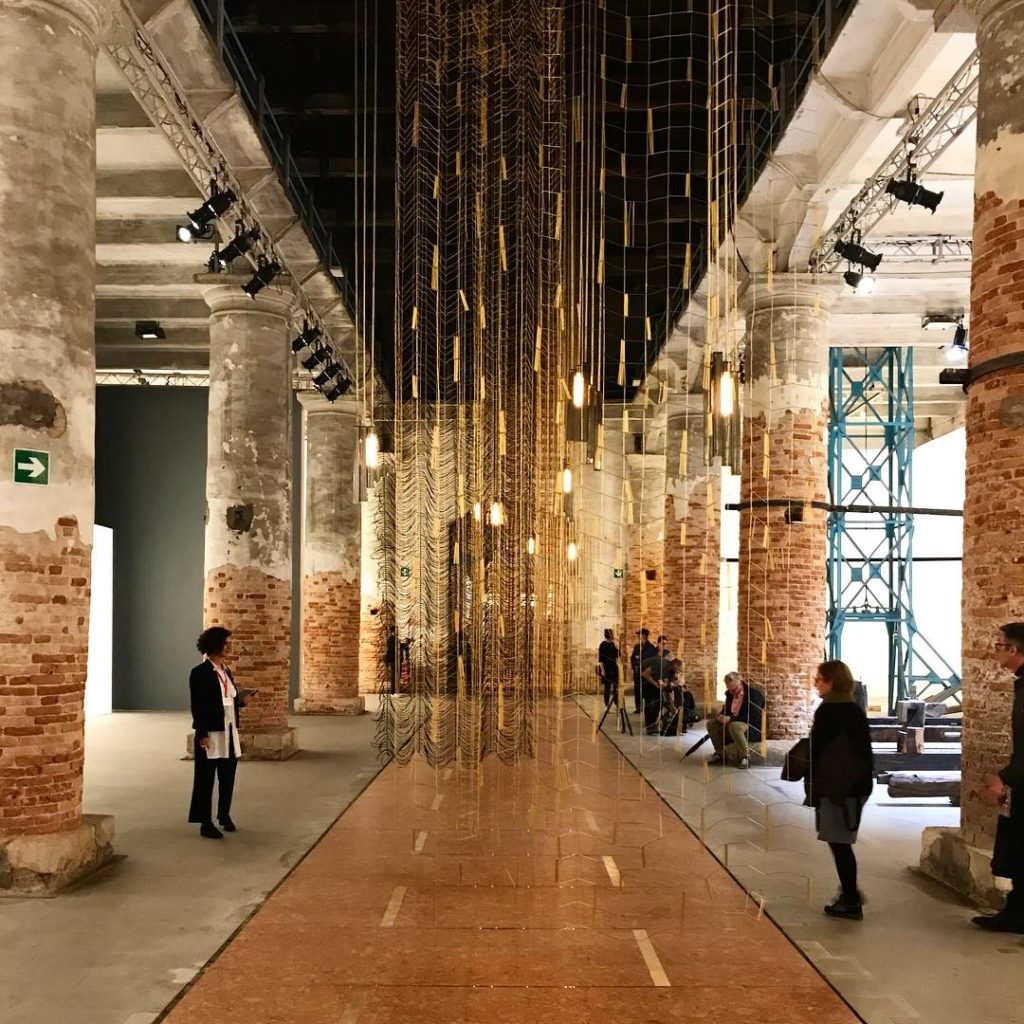
Installation view of Leonor Antunes’s …then we raised the terrain so that I could see out. (2017) in the Arsenale at the Venice Biennale. Photo: © Photo: Haupt & Binder.
Although the Venice Biennale, documenta 14, and Skulptur Projekte Münster could not have been more different, some of the strongest works share an interest in architecture. Informed by Italian architects Carlo Scarpa and Franco Albini, Leonor Antunes’s suspended sculptures, lights, and flooring in the Arsenale in Venice bring lightness and grace to a rather heavy-handed exhibition in a monumental space. In Münster, Pierre Hughye’s project in the Eis Palast introduces living organisms and technological systems in the vast former ice skating rink and opens the structure to external environmental elements, turning it into a complex ecosystem. Architecture also has a leading role in a three-channel video installation by Naeem Mohaiemen in Kassel; the story of the newly formed state of Bangladesh is played out at the end of the Cold War in the Palais des Nations in Algiers, the UN Building in New York, and other settings of power.
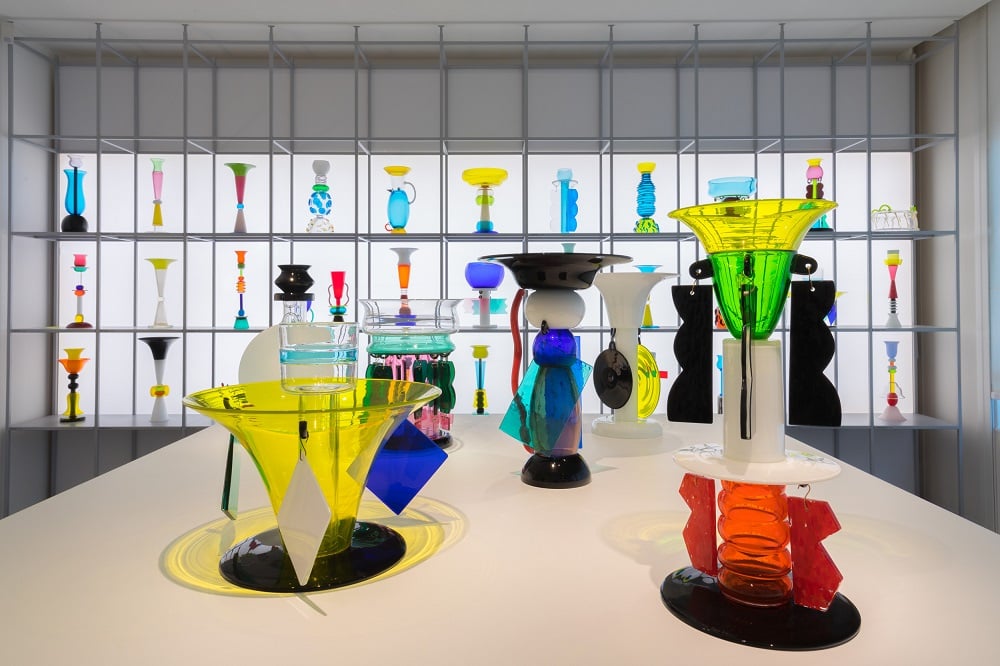
Installation view of the Memphis room in “Ettore Sottsass: il vetro” at the Cini Foundation. ©Ettore Sottsass by SIAE 2017. Photo by Enrico Fiorese.
One of my personal highlights this summer, as it was so unexpected, was without question the exhibition of Ettore Sottsass‘s works of glass at the Cini Foundation in Venice. The exquisite beauty of these fragile sculptures came to light most stunningly in the striking abundance and the sheer number of works aligned next to each other. It was magnificent to see the many shapes you can give to the material of glass. The exhibition was a celebration of form and a blast of colors that is rarely to be seen. Sottsass again and again impresses me deeply.
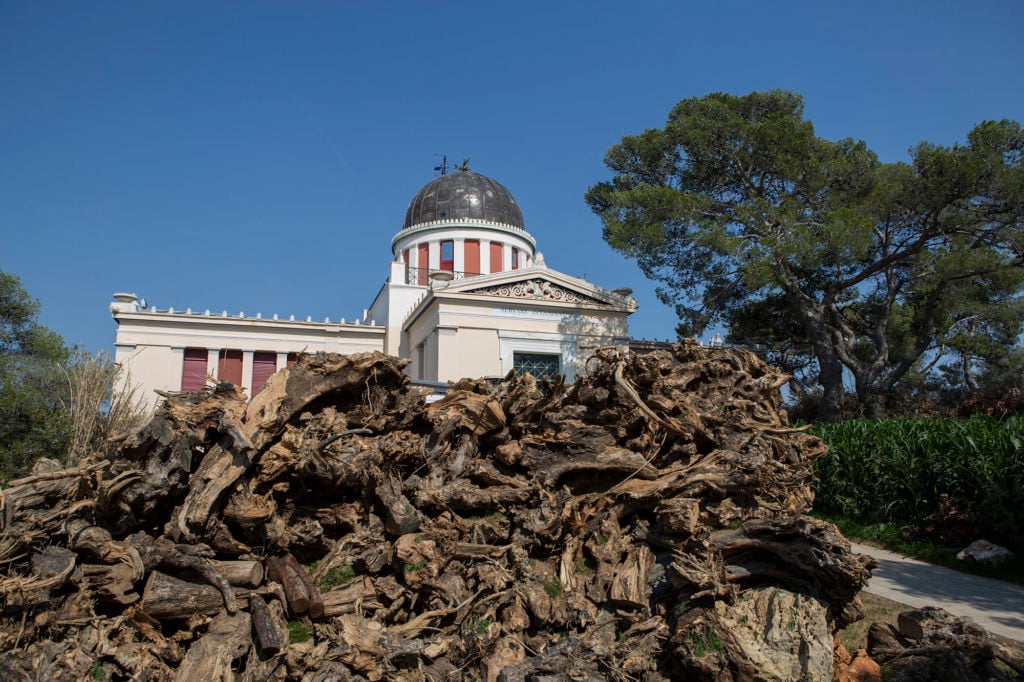
Adrián Villar Rojas’s “The Theater of Disappearance,” at the National Observatory of Athens, Hill of the Nymphs. © NataliaTsoukala Courtesy NEON.
Adrián Villar Rojas’s The Theater of Disappearance at the National Observatory of Athens. It’s a complete transformation of the Hill of Nymphs in Athens. Works of such immense scale are often very seductive, but what is deeply moving here is the scale of the work’s ambition: It conjures from the site centuries of global history, wars, and the construction of civilization and national identity.
Part two of this series will appear online tomorrow.